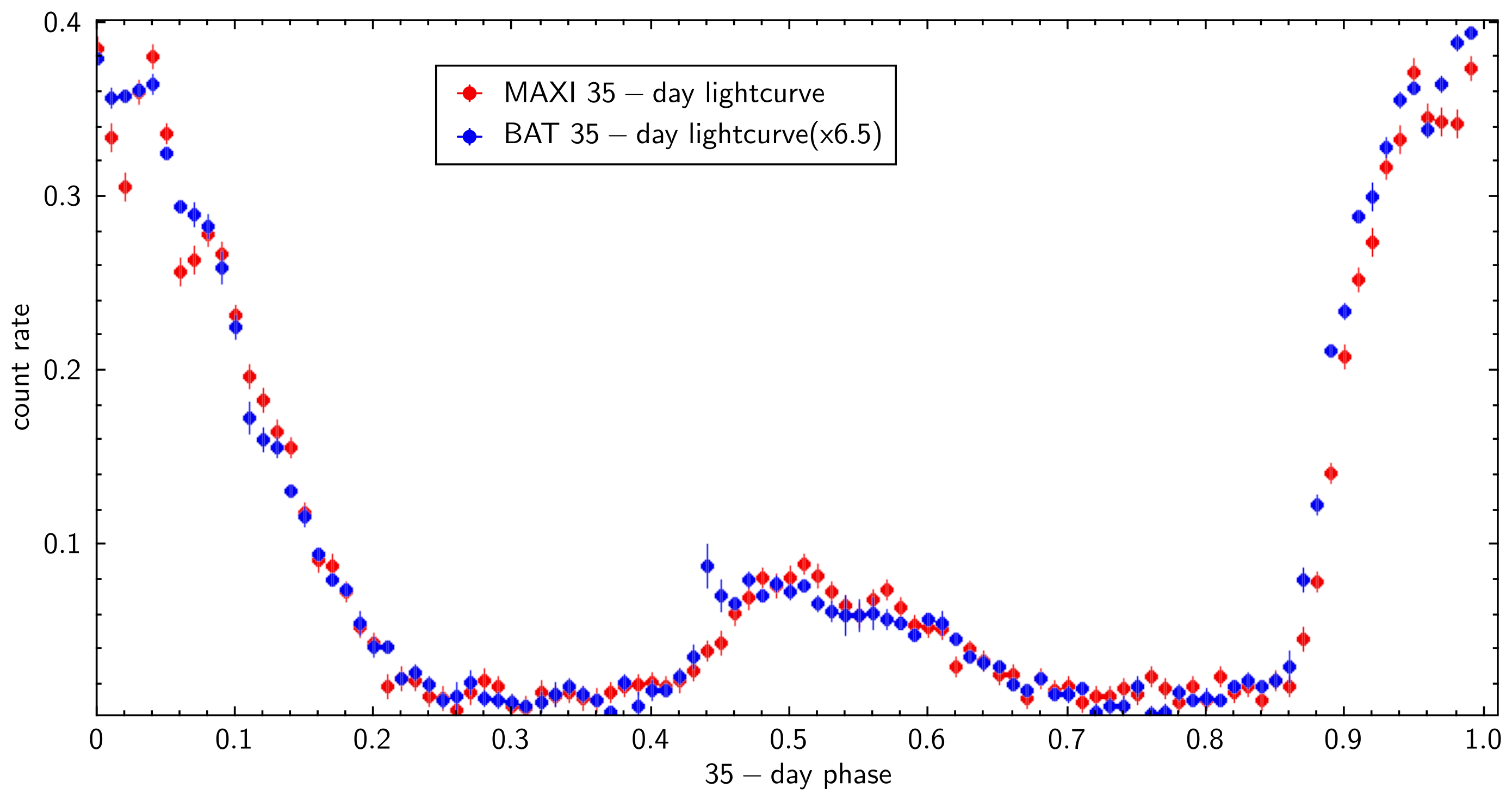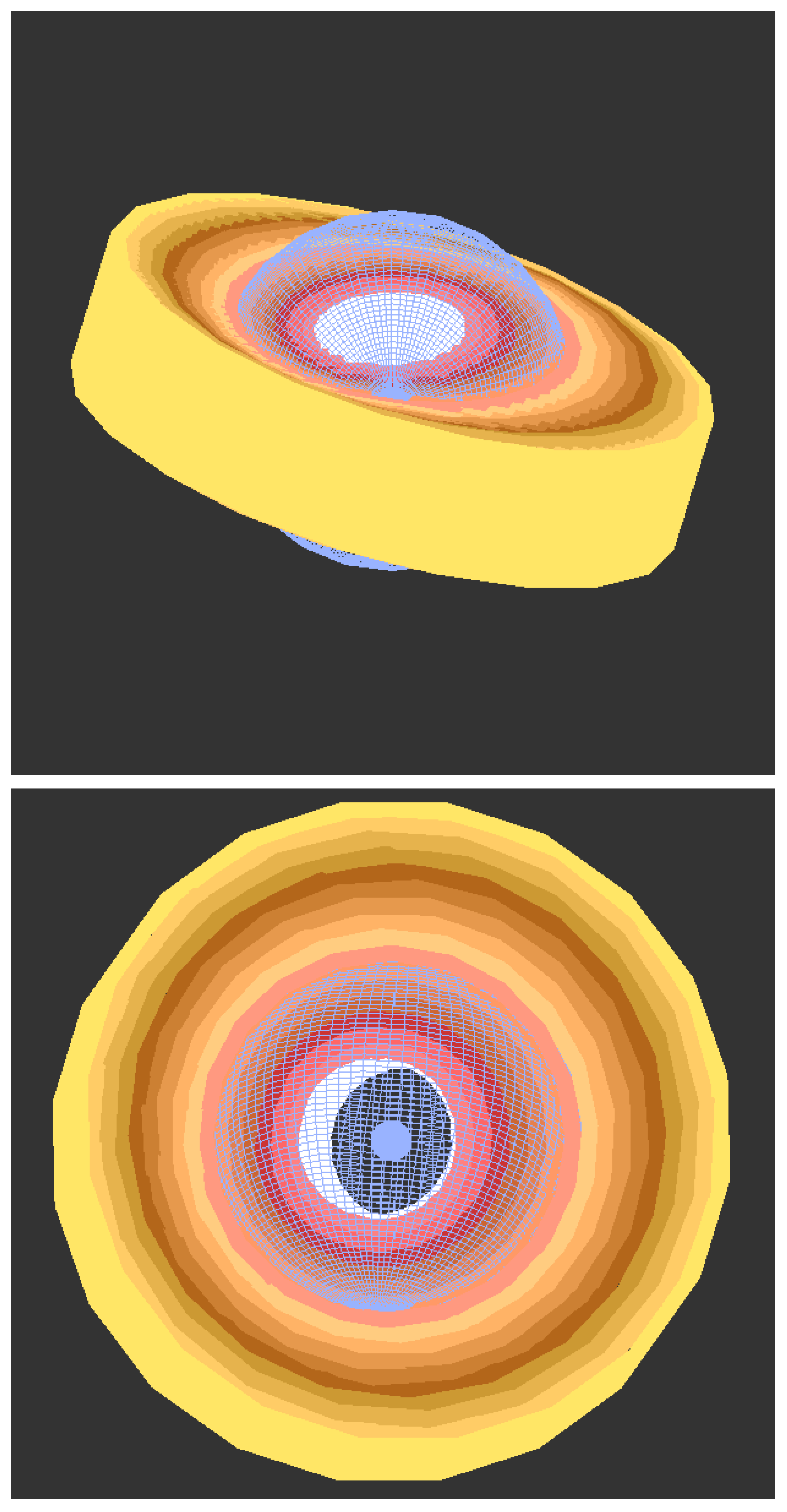A Model for the Accretion Disk of Hercules X-1 from 35-Day Cycle Lightcurves
Abstract
1. Introduction
2. 35-Day X-Ray Lightcurves of Her X-1 from BAT and MAXI
3. Analysis Method
4. Model Description
4.1. Simulation Implementation
4.2. Disk Properties
4.3. Corona Properties
4.4. Radial Scaling Factor
5. Results
6. Discussion
6.1. Model Fitting Process
6.2. Interpretation in Terms of a Physical Model
6.3. The Disk and Comparison with Previous Work
6.4. Disk Corona
6.5. System Inclination
7. Summary
Author Contributions
Funding
Institutional Review Board Statement
Data Availability Statement
Conflicts of Interest
| 1 | Ref. [13] reports changing polarization of Her X-1 for five different 35-day phases, and suggest the cause as free precession of the neutron star, but no quantitative argument is given to distinguish between neutron star precession and changing reprocessed emission from the rotating accretion disk. In contrast, ref. [7] present detailed arguments on why pulse profile changes are caused by the disk and not neutron star precession. Ref. [14] observed synchronization between pulse profile changes and the disk rotation period, which argues further (though not stated by the authors) that disk rotation is the cause of the 35-day flux cycle and the pulse profile changes. |
| 2 | Computing was carried out on a 2024 Dell Laptop with Core i7-1255U processor with 10 cores maximum clock speed 4.7 GHz, 16 GB DDR4 2666MHz RAM, operating system Windows 11 Pro. |
| 3 | However this is degenerate with the constant B in Equation (1). Shape does not track multiple scattering, so that the density constant is not accurate. |
| 4 | See Table 2 of [20] for phases of the different states of Her X-1. |
| 5 | A few of the values in [31] need to be updated. |
References
- Leahy, D.A.; Abdallah, M.H. HZ Her: Stellar Radius from X-Ray Eclipse Observations, Evolutionary State, and a New Distance. Astrophys. J. 2014, 793, 79. [Google Scholar] [CrossRef]
- Reynolds, A.P.; Quaintrell, H.; Still, M.D.; Roche, P.; Chakrabarty, D.; Levine, S.E. A new mass estimate for Hercules X-1. Mon. Not. R. Astron. Soc. 1997, 288, 43–52. [Google Scholar] [CrossRef]
- Staubert, R.; Klochkov, D.; Wilms, J. Updating the orbital ephemeris of Hercules X-1; rate of decay and eccentricity of the orbit. Astron. Astrophys. 2009, 500, 883–889. [Google Scholar] [CrossRef]
- Wang, Y.; Leahy, D. The Evolution of the Orbital Lightcurve of Hercules X-1 with 35 Day Phase. Astrophys. J. 2022, 927, 143. [Google Scholar] [CrossRef]
- Petterson, J.A. The 35 day cycle of the X-ray binary Hercules X-1. Astrophys. J. 1977, 218, 783–791. [Google Scholar] [CrossRef]
- Leahy, D.; Wang, Y. Swift/BAT and RXTE/ASM Observations of the 35 day X-Ray Cycle of Hercules X-1. Astrophys. J. 2020, 902, 146. [Google Scholar] [CrossRef]
- Scott, D.M.; Leahy, D.A.; Wilson, R.B. The 35 Day Evolution of the Hercules X-1 Pulse Profile: Evidence for a Resolved Inner Disk Occultation of the Neutron Star. Astrophys. J. 2000, 539, 392–412. [Google Scholar] [CrossRef]
- Gerend, D.; Boynton, P.E. Optical clues to the nature of Hercules X-1/HZ Herculis. Astrophys. J. 1976, 209, 562–573. [Google Scholar] [CrossRef]
- Leahy, D.A. Modelling RXTE/ASM observations of the 35-d cycle in Her X-1. Mon. Not. R. Astron. Soc. 2002, 334, 847–854. [Google Scholar] [CrossRef]
- Leahy, D.A. Hercules X-1: Using Eclipse to Measure the X-Ray Corona. Astrophys. J. 2015, 800, 32. [Google Scholar] [CrossRef]
- Wijers, R.A.M.J.; Pringle, J.E. Warped accretion discs and the long periods in X-ray binaries. Mon. Not. R. Astron. Soc. 1999, 308, 207–220. [Google Scholar] [CrossRef]
- Leahy, D.A.; Postma, J.; Chen, Y. AstroSat UVIT Observations of Her X-1. Astrophys. J. 2020, 889, 131. [Google Scholar] [CrossRef]
- Heyl, J.; Doroshenko, V.; González-Caniulef, D.; Caiazzo, I.; Poutanen, J.; Mushtukov, A.; Tsygankov, S.S.; Kirmizibayrak, D.; Bachetti, M.; Pavlov, G.G.; et al. Complex rotational dynamics of the neutron star in Hercules X-1 revealed by X-ray polarization. Nat. Astron. 2024, 8, 1047–1053. [Google Scholar] [CrossRef]
- Staubert, R.; Klochkov, D.; Postnov, K.; Shakura, N.; Wilms, J.; Rothschild, R.E. Two ~35 day clocks in Hercules X-1: Evidence for neutron star free precession. Astron. Astrophys. 2009, 494, 1025–1030. [Google Scholar] [CrossRef]
- Steffen, W.; Koning, N.; Wenger, S.; Morisset, C.; Magnor, M. Shape: A 3D Modeling Tool for Astrophysics. IEEE Trans. Vis. Comput. Graph. 2011, 17, 454–465. [Google Scholar] [CrossRef] [PubMed]
- Inoue, H. Reproductions of super-orbital X-ray light-curves with the precessing accretion ring model and implications on accretion flows through accretion rings. Publ. Astron. Soc. Jpn. 2019, 71, 36. [Google Scholar] [CrossRef]
- Inoue, H. Tidal-Force-Induced Precessions of Accretion Disks. Publ. Astron. Soc. Jpn. 2012, 64, 40. [Google Scholar] [CrossRef]
- Leahy, D.; Mendelsohn, J. The geometry of the Hercules X-1 accretion disk from X-rays. Discov. Space 2025, 129, 5. [Google Scholar] [CrossRef]
- Matsuoka, M.; Kawasaki, K.; Ueno, S.; Tomida, H.; Kohama, M.; Suzuki, M.; Adachi, Y.; Ishikawa, M.; Mihara, T.; Sugizaki, M.; et al. The MAXI Mission on the ISS: Science and Instruments for Monitoring All-Sky X-Ray Images. Publ. Astron. Soc. Jpn. 2009, 61, 999. [Google Scholar] [CrossRef]
- Leahy, D.; Wang, Y. The 35-Day Cycle of Hercules X-1 in Multiple Energy Bands from MAXI and Swift/BAT Monitoring. Universe 2021, 7, 160. [Google Scholar] [CrossRef]
- Krimm, H.A.; Holland, S.T.; Corbet, R.H.D.; Pearlman, A.B.; Romano, P.; Kennea, J.A.; Bloom, J.S.; Barthelmy, S.D.; Baumgartner, W.H.; Cummings, J.R.; et al. The Swift/BAT Hard X-Ray Transient Monitor. Astrophys. J. Suppl. 2013, 209, 14. [Google Scholar] [CrossRef]
- Leahy, D.A.; Igna, C. The Light Curve of Hercules X-1 as Observed by the Rossi X-Ray Timing Explorer. Astrophys. J. 2011, 736, 74. [Google Scholar] [CrossRef]
- dal Fiume, D.; Orlandini, M.; Cusumano, G.; del Sordo, S.; Feroci, M.; Frontera, F.; Oosterbroek, T.; Palazzi, E.; Parmar, A.N.; Santangelo, A.; et al. The broad-band (0.1–200 keV) spectrum of HER X-1 observed with BeppoSAX. Astron. Astrophys. 1998, 329, L41–L44. [Google Scholar] [CrossRef]
- Press, W.H.; Teukolsky, S.A.; Vetterling, W.T.; Flannery, B.P. Numerical Recipes in C++: The Art of Scientific Computing; Cambridge University Press: Cambridge, UK, 2002. [Google Scholar]
- Shakura, N.I.; Sunyaev, R.A. Black holes in binary systems. Observational appearance. Astron. Astrophys. 1973, 24, 337–355. [Google Scholar]
- Zhao, Q.C.; Li, H.C.; Tao, L.; Feng, H.; Zhang, S.N.; Walter, R.; Ge, M.Y.; Tong, H.; Ji, L.; Zhang, L.; et al. Polarization perspectives on Hercules X-1: Further constraining the geometry. Mon. Not. R. Astron. Soc. 2024, 531, 3935–3949. [Google Scholar] [CrossRef]
- Doroshenko, V.; Poutanen, J.; Tsygankov, S.S.; Suleimanov, V.F.; Bachetti, M.; Caiazzo, I.; Costa, E.; Di Marco, A.; Heyl, J.; La Monaca, F.; et al. Determination of X-ray pulsar geometry with IXPE polarimetry. Nat. Astron. 2022, 6, 1433–1443. [Google Scholar] [CrossRef]
- Leahy, D.A. Mapping the shape of the accretion disk of Hercules X-1. Astron. Nachrichten 2004, 325, 205–208. [Google Scholar] [CrossRef]
- Leahy, D.A.; Leahy, J.C. A calculator for Roche lobe properties. Comput. Astrophys. Cosmol. 2015, 2, 4. [Google Scholar] [CrossRef]
- Still, M.D.; Quaintrell, H.; Roche, P.D.; Reynolds, A.P. Spectral signatures of reprocessing on the companion and accretion disc of Hercules X-1. Mon. Not. R. Astron. Soc. 1997, 292, 52–62. [Google Scholar] [CrossRef]
- Özel, F.; Freire, P. Masses, Radii, and the Equation of State of Neutron Stars. Annu. Rev. Astron. Astrophys. 2016, 54, 401–440. [Google Scholar] [CrossRef]






| Fixed Parameters | Value | |
|---|---|---|
| Disk Inner Radius (km) | ||
| Disk Outer Radius (km) | ||
| Inner Twist (degrees) | 75.5 | |
| Corona Outer Radius (km) | ||
| Variable parameters (geometry) | Value | 1-error |
| BAT Inclination (Degrees) | 85.17 | 0.15 |
| MAXI Inclination (Degrees) | 85.07 | 0.19 |
| BAT Inner Tilt (degrees) | 22.5 | 0.7 |
| MAXI Inner Tilt (degrees) | 24.0 | 1.0 |
| BAT Outer Tilt (degrees) | 17 | 3 |
| MAXI Outer Tilt (degrees) | 24 | 4 |
| BAT Outer Twist (degrees) | 22 | 4 |
| MAXI Outer Twist (degrees) | 22 | 4 |
| BAT | 0.26 | 0.05 |
| MAXI | 0.23 | 0.06 |
| Variable parameters (other) | ||
| BAT Disk Density () | ||
| MAXI Disk Density () | ||
| BAT Inner Scale Height (rad) | 0.06 | |
| MAXI Inner Scale Height (rad) | 0.08 | |
| BAT Outer Scale Height (rad) | 0.018 | |
| MAXI Outer Scale Height (rad) | 0.100 | 0.023 |
| BAT Corona Powerlaw Index | −0.6 | 0.5 |
| MAXI Corona Powerlaw Index | −1.3 | 0.6 |
| BAT Disk Phase Shift (35-day phase) | 0.211 | 0.006 |
| MAXI Disk Phase Shift (35-day phase) | 0.205 | 0.007 |
| Goodness of fit | ||
| BAT | 160 | |
| MAXI | 105 |
Disclaimer/Publisher’s Note: The statements, opinions and data contained in all publications are solely those of the individual author(s) and contributor(s) and not of MDPI and/or the editor(s). MDPI and/or the editor(s) disclaim responsibility for any injury to people or property resulting from any ideas, methods, instructions or products referred to in the content. |
© 2025 by the authors. Licensee MDPI, Basel, Switzerland. This article is an open access article distributed under the terms and conditions of the Creative Commons Attribution (CC BY) license (https://creativecommons.org/licenses/by/4.0/).
Share and Cite
Leahy, D.; Frost, S. A Model for the Accretion Disk of Hercules X-1 from 35-Day Cycle Lightcurves. Universe 2025, 11, 381. https://doi.org/10.3390/universe11120381
Leahy D, Frost S. A Model for the Accretion Disk of Hercules X-1 from 35-Day Cycle Lightcurves. Universe. 2025; 11(12):381. https://doi.org/10.3390/universe11120381
Chicago/Turabian StyleLeahy, Denis, and Samuel Frost. 2025. "A Model for the Accretion Disk of Hercules X-1 from 35-Day Cycle Lightcurves" Universe 11, no. 12: 381. https://doi.org/10.3390/universe11120381
APA StyleLeahy, D., & Frost, S. (2025). A Model for the Accretion Disk of Hercules X-1 from 35-Day Cycle Lightcurves. Universe, 11(12), 381. https://doi.org/10.3390/universe11120381






